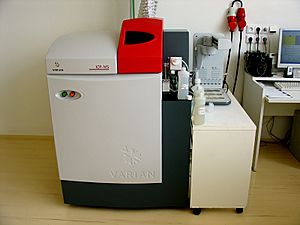Inductively coupled plasma mass spectrometry facts for kids

ICP-MS Instrument
|
|
| Acronym | ICP-MS |
|---|---|
| Classification | Mass spectrometry |
| Analytes | Tiny particles (atoms and molecules) in a super hot gas (plasma) |
| Manufacturers | Agilent, Bruker, Horiba, PerkinElmer, Shimadzu, Spectro, Thermo |
| Other techniques | |
| Related | Inductively coupled plasma atomic emission spectroscopy |
| Hyphenated | Liquid chromatography-inductively coupled plasma mass spectrometry, Gas chromatography-inductively coupled plasma mass spectrometry |
Inductively coupled plasma mass spectrometry (ICP-MS) is a very powerful scientific tool. It is a type of mass spectrometry. This machine can find tiny amounts of different substances in a sample. It is especially good at finding metals and some non-metals.
ICP-MS can detect substances even if they are present in extremely small amounts. We are talking about less than one part in a trillion! This is like finding one specific grain of sand on a huge beach. The machine works by combining two main parts. First, it uses an inductively coupled plasma. This plasma is a super hot gas that turns the sample into electrically charged particles called ions. Second, it uses a mass spectrometer. This part separates and counts these ions.
Scientists often use Argon gas to create the plasma. The sample is introduced into this plasma. Then, the charged particles from the sample travel through a series of small cones. These cones carefully guide the ions into a special vacuum chamber. Inside this chamber, the mass spectrometer does its job.
Contents
What ICP-MS Does Best
ICP-MS is very useful for finding very small amounts of elements. It is much faster and more accurate than older methods. It can also find many different elements at the same time.
Advantages of Using ICP-MS
- High Speed: It can analyze samples very quickly.
- Great Accuracy: The results are very precise and reliable.
- Super Sensitive: It can find incredibly tiny amounts of substances.
Challenges with ICP-MS Analysis
Even though it's great, ICP-MS has some challenges. Because it is so sensitive, even tiny bits of dirt can affect the results. This means that the labware and chemicals used must be extremely clean. Also, some substances are difficult to analyze with ICP-MS. Sometimes, scientists need to do extra tests to make sure the results are correct.
Many Uses of ICP-MS Technology
ICP-MS has many different uses. It can do more things than other similar machines like ICP-OES. One special thing it can do is look at different forms of the same element. This is called isotopic speciation.
Important Applications of ICP-MS
- Environmental Testing: Checking water, soil, and air for pollution.
- Food Safety: Making sure food is safe by testing for harmful metals.
- Medical Research: Studying elements in the human body.
- Geology: Analyzing rocks and minerals to understand the Earth.
- Forensics: Helping solve crimes by analyzing tiny samples.
Because ICP-MS is such a powerful tool, its parts are carefully controlled. There are special rules about sending ICP-MS equipment to other countries. This is because the technology can be used for very important and sensitive scientific work.
Images for kids
See also
 In Spanish: ICP-MS para niños
In Spanish: ICP-MS para niños


